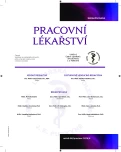Provision of health surveillance in the employees giving dialysis service from the occupational infection standpoint
Authors:
Rošková Dana 1; Hrušková Mária 2; Švihrová Viera 1; Buchancová Jana 1,2; Rosenberger Jaroslav 3; Mitošinková Marianna 3
Authors‘ workplace:
Ústav verejného zdravotníctva JLF UK Martin, Univerzita Komenského Bratislava, Slovensko vedúca prof. MUDr. Henrieta Hudečková, Ph. D., MPM
1; ŽILPO, s. r. o., Žilina, Slovensko vedúci MUDr. Štefan Zelník, Ph. D.
2; FMC – dialyzačné služby, s. r. o., Piešťany, Slovensko vedúci Ing. René Kolář
3
Published in:
Pracov. Lék., 66, 2014, No. 4, s. 145-150.
Category:
Original Papers
*Práca bola v skrátenej forme prednesená na VII. ročníku Kongresu nemocí z povolání s mezinárodní účastí, 16.–17. október 2014, Luhačovice.
Overview
Dialysis workplaces belong to those which pose a high risk in relation to the types of patients treated as well as considering the number of parenteral infections, permanent communication with the vascular system, application of dialysis therapy, sharing the ward with other patients with higher prevalence of markers of all types of blood-transformed hepatitis, common hospital personnel and high requirements for the barrier treatment system. The authors pointed out the risk for the medical personnel related to injury, evaluated the provision of health surveillance of the employees in view of the risks of acquired blood transmitted infections in the working of environment of dialysis services, and evaluated cost-benefit of vaccination against hepatitis type B (VHB). Nineteen centrally-controlled non-state dialysis centers in the nephrology branch with a total of 531 employees were evaluated. The data for evaluation of the health risks for the employees in accord with legislation requirements were obtained in collaboration with the FMC association (dialysis services leadership from the records of injuries of the employees and from the EuClid database. In the observed period of time, 36 injuries of the medical employees were recorded. Most injuries occurred in nurses (61%), followed by orderlies (25%), charladies (11%), whereas there was only one case of a physician. Injuries caused by the use needles were most frequent (67%). The guarantee of pre-exposure prophylaxis meaning a complete vaccination again VHB was fulfilled in 97% of the employees. All employees exposed to blood or blood derivatives of the patients underwent blood sampling for detection of antibodies against viral hepatitis B and C within the framework of post-exposure prophylaxis. The authors consider provision of employee’s medical surveillance of the dialysis workplaces as optimal or above common standard. This has been reflected by observations that in the control sampling in employees of the dialysis workplaces under surveillance, no occupational infection diseases have been encountered. The vaccination of employees represents an immensely lower economic load for the health institution in comparison with direct or indirect cost of diagnostics and therapy of VHB.
Keywords:
dialysis – injuries of medical personnel – virus hepatitis type B and C – cost-benefit of vaccination
Sources
1. Bolon, M. Hepatitis B exposure in a dialysis unit. 2011. Dostupné na www: <http://apicchicago.org/pdf/2011/Hepatitis-B-Exposure-Dialysis-Unit.pdf>
2. Centers for disease control and prevention. Hepatitis C Virus Transmission at an Outpatient Hemodialysis Unit in New York 2001–2008. Dostupné na www: <http://www.cdc.gov/mmwr/preview/mmwrhtml/mm5808a2.htm>
3. Centers for disease control and prevention. Infection Control Requirements for Dialysis Facilities and Clarification Regarding Guidance on Parenteral Medication Vials. 2008. Dostupné na www: <http://www.cdc.gov/mmwr/preview/mmwrhtml/mm5732a3.htm>
4. Centers for disease control and prevention. Outbreaks of hepatitis B virus infection among hemodialyis patients – California, Nebraska, and Texas in 1994. MMWR, 1996, roč. 45, č. 14, s. 285–289.
5. Centers for disease control and prevention. Recommendations for preventing transmission of infections among chronic hemodialysis patients. MMWR, 2001, roč. 50, č. 5, s. 1–46.
6. Fisman, D. et al. Willingness to pay to avoid sharps-related injuries: A study in injured health care workers. American Journal of Infection Control., 2002, roč. 30, č. 5, s. 283–287.
7. Hudečková, H., Švihrová, V. Očkovanie. Martin: Osveta, 2013, s. 160–164.
8. Jagger, J. et al. The impact of U.S. policies to protect healthcare workers from bloodborne pathogens: the critical role of safety-engineered devices. Journal of Infection and Public Health, 2008, roč. 1, č. 2, s. 62–71.
9. Ladou, J. Curent occupational and environmental medicine. IV. ed. New York: McGraw Hill Medical, 2007, 846 s.
10. O’Malley, E. et al. Costs of management of occupational exposures to blood and body fluids. Infection Control and Hospital Epidemiology, 2007, roč. 28, č. 7, s. 774–782.
11. Saia, M. Needlestick Injuries: Incidence and Cost in the United States, United Kingdom, Germany, France, Italy, and Spain. Biomedicine International., 2010, roč. 1, č. 2, s. 41–49.
12. Štefkovičová, M., et al. Dezinfekcia a sterilizácia, teória a prax II. Žilina: Vrana, 2007, 164 s.
13. Thompson, N. D., Perz, J. F., Moorman, A. C., Holmberg, S. D. Nonhospital health care-associated hepatitis B and C virus transmission: United States, 1998–2008. Annals of Internal Medicine, 2009, roč. 150, č. 1, s. 33–39.
14. Vyhláška MZ SR č. 585/2008 Z. z, ktorou sa ustanovujú podrobnosti o prevencii a kontrole prenosných ochorení.
15. Vestník Ministerstva zdravotníctva Slovenskej republiky. 91. Odborné usmernenie na vykonávanie liečby nahrádzajúcej funkciu obličiek a na vykonávanie mimotelovej eliminačnej liečby. 2006, roč. 54, čiastka 43–47.
Labels
Hygiene and epidemiology Hyperbaric medicine Occupational medicineArticle was published in
Occupational Medicine

2014 Issue 4
Most read in this issue
- Vacuum compression therapy in occupational medicine
- Central nervous toxicity incidence during hyperbaric oxygen therapy depending on the scheme of breathing oxygen
- Provision of health surveillance in the employees giving dialysis service from the occupational infection standpoint
- Health protection at work in the network of dialysis workplaces
